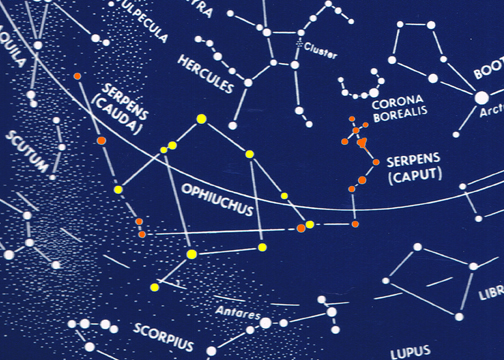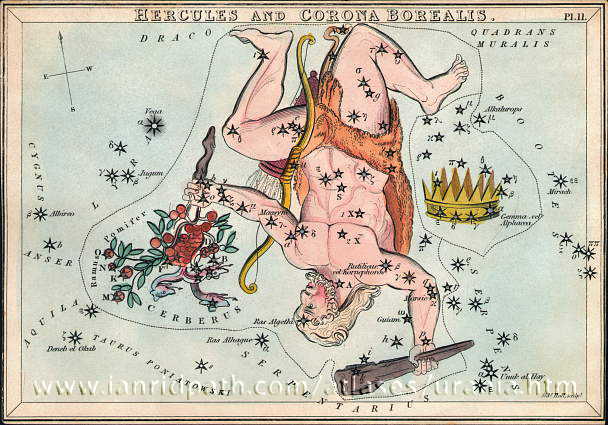Völund Star-Smith:
The Kneeling man and the Virgin with the Golden Ringby Peter Krüger
©2012
Return to Germanic Astronomy
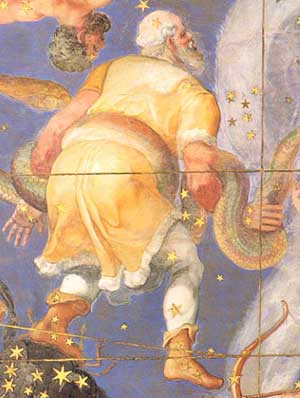
Introduction:
Account of the Method Used
The task of the following investigation of Völundarkviða is to shed new
light on the origin of this poem by comparing the main figures of the
tale and their attributes with Greek and Roman mythology and
astronomy. This doesn’t mean that Völundarkvida is to be understood as
a Greek “Wandersage”, but since the main actor Völund, described as a lame
smith, has a counterpart in Hephaistos/Vulcan in the classic mythology
and the name Nidud (Nidhad, 'the lower one'), best describes a ruler in
the lower world reminiscent of the Greek Hades, this approach might be
useful
to identify common roots of the tales. The approach itself —comparing
Eddic tales with Greek constellations— is not new, I just want to mention
the recent work of Björn Jonsson (Star Myths of the Vikings, 1994) or
the work of
Timothy J. Stephany, published in several articles.
It is assumed as a premise that the poet of Völundarkviða
intends to provide clues for the identification of its characters as stars or
constellations. To avoid circular arguments this work will intentionally focus on the tale itself without using other northern sources. In this
work, we will use the English translation of Bellows.
As a first step to identifying the figures of Völundarkviða as stars or
star constellations it is important to screen the tale for hints such as
specific attributes. Looking through the text of Völundarkviða there is
indeed a very interesting passage to start with. Within two strophes
(and some prose) for all the three main actors of the tale there are
specific attributes or characteristics mentioned that could help
identification:
“King Nithuth gave to his daughter Bothvild the
gold ring that he had taken
from the bast rope in Völund's house, and he himself wore the
sword that Völund had had.
The queen spoke:
18. "The glow of his eyes | is like
gleaming snakes,
His teeth he gnashes | if now is shown
The sword, or Bothvild's | ring he sees;
Let them straightway cut | his sinews of
strength,
And set him then | in Sævarstath."
So was it done: the sinews in his
knee-joints were cut, and he was set in an island which was near the
mainland, and was called Sævarstath. There he smithied for the king all
kinds of precious things. No man dared to go to him, save only the king
himself. Völund spake:
19. "At Nithuth's girdle | gleams
the sword
That I sharpened keen | with
cunningest craft,
(And hardened the steel | with
highest skill;)
The bright blade far | forever is
borne,
(Nor back shall I see it | borne
to my smithy;)
Now Bothvild gets | the golden
ring
(That was once my bride's,-- | ne'er well shall it be.)"
Völund, the Kneeling Man
The main actor of the tale, Völund, is described as a smith. At
first glance, there seems to be no fitting constellation. There is no
constellation named Hephaistos or Volcanus we could compare Volund with.
But at least there is a long list of items ascribed to Hephaistos,
amongst them e.g. the constellation
Corona Borealis, the
Northern Crown. Corona
Borealis was sometimes considered to represent a crown that was given by
Dionysos
to
Ariadne,
the daughter of
Minos
of Crete (the story is told by
Ovid,
"Fasti" III 459-516). But actually, as we follow the hints of
Völundarkviða we are not looking for a constellation depicting a smith
but for a
“man with cut sinews in his knee joints”.
Focusing specifically on this description there is indeed an interesting
candidate:
"Next to the chill Bears and the frozen north comes a figure on bended
knee [Engonasin],
the reason for whose posture is known to none but him." [Manilius,
Astronomica,
1st century, AD, p.29.]
"Hercules,
the figure on bended knee and called by the Greek name of
Engonasin, about whose origin no certainty prevails. Of
this constellation is begotten the desertion, craftiness, and deceit
characteristic of its children, and from it comes the thug who
terrorizes the heart of the city. If perchance his mind is moved to
consider a profession,
Engonasin will inspire him with enthusiasm for risky
callings, with danger the price, for which he will sell his talents:
daring narrow steps on a path without thickness, he will plant firm feet
on a horizontal tightrope; then, as he attempts an upward route to
heaven, (on a sloping tightrope) he will all but lose his footing and,
suspended in mid-air, he will keep a multitude in suspense upon himself"
[Manilius,
Astronomica,
1st century, AD, p.353.]
A figure on bended knee could indeed be another description for a man
with cut sinews in the knee. The constellation Engonasin, the kneeling
man, was in later times identified with Herakles the greatest hero of
Greek history. Herakles has been one of few figures that survived a trip
to Hades and came back alive, an interesting parallel to
Volund who managed to escape from the realm of Nidud, the
underworld ruler.
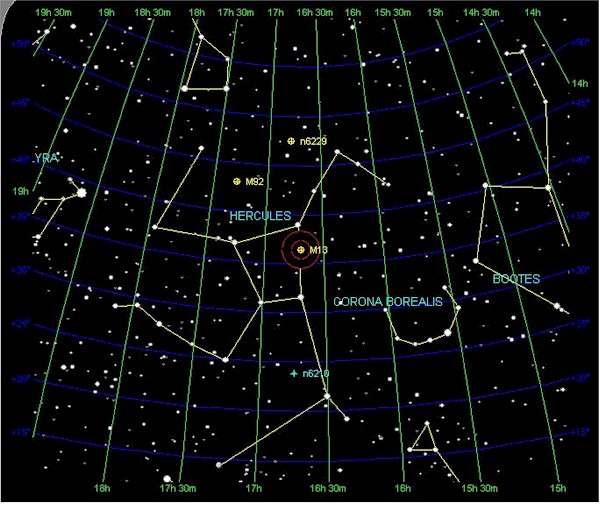
The constellation Hercules is depicted headlong on star maps. This
reminds to the story of Hephaistos who was thrown out of heaven from
Hera either because he was lame or in other versions he became lame from
the fall. In one version he landed on an island, in other versions in
the ocean.
Two of the many epithets for Hercules were Greek
Korunetes, and
Korunephoros, the equivalents of Latin
Clavator and
Claviger, Club-bearer. The club could easily be compared
to the hammer of a smith. As mentioned before, exactly next to Hercules
we can find the golden ornament Corona Borealis, the Northern Crown
forged by the lame smith Hephaistos. Another interesting epithet is
Kharops, the keen-eyed one, a phrase similar to the
expression in Völundarkviða: “The
glow of his eyes | is like gleaming snakes”.
Also interesting is that Hercules is brought into connection of the
Milky Way. One account of the origin of the Milky Way is that Zeus, who
wanted to make Hercules immortal, had tricked Hera into nursing the
infant Hercules; discovering who he was when she woke up, she pulled him
from her breast, and a spurt of her milk formed the smear across the sky
to become the Milky Way. Rydberg always pointed out the connection of
Volund and his brothers to the Milky Way.
The name of Hercules is in most cases translated as “glory of Hera”.
However, as the name Hera is believed to relate to the word air it could
also be understood as “glory of the air or “clashing against the air”.
"But inasmuch as the sun wards off the evils of the earth, they
called him Heracles (from his clashing against the
air) in passing from east to west. And they invented
fables of his performing twelve labours, as the symbol
of the division of the signs of the zodiac in heaven; and they arrayed him with a club and a lion's skin, the one as an
indication of his uneven motion, and the other
representative of his strength in "Leo" the sign of
the zodiac." [Porphyry,
On Images, (c. 232 AD - c. 304), Fragment 8.]
Overall it seems that an identification of Volund and the kneeling man
could make a lot of sense. But, to proof this identification that could
be coincidence we should also be able to find the young woman with a
ring at the finger and a man with a sword at his girdle.
Bödhild, the Virgin with the Golden Ring
Searching at the GrGermanic
Astronomyeek starry sky for a young woman next to Hercules we
obviously have to take a closer look to the constellation
Virgo. Virgo
is depicted normally with a staff or rod in her right hand and an ear of
grain in her left hand. The word Virgo itself is often explained as
meaning “twig, young shoot”. Virgo is thought to represent in one tale
Erigone who on finding her father Icarius (Bootes)
dead, hanged herself in grief and was raised to heaven. An alternative
story (cf.
Aratus,
Phaen.
98 ff.) identified her as
Astraea, literally the star-maiden. We should also mention the story of
Persephone living both in Hades and in Olympus.
As an interesting side aspect the very bright star Spica, the ear of
grain is not always seen as part of the constellation Virgo but as a
separate constellation. It is tempting to identify Virgo, the star
maiden Astraea, with Bodvild and assume that Spica, the ear of grain in
her hand of the Greek story is thought to be a ring in the Northern
myth.
Nidud, the Possessor of Völund's sword
After having found a kneeling man and a young maiden with an attribute
in her hand that could be interpreted as a ring we have now to search
for a man with a sword at his girdle. A starting point could be the tale
of Erigone mentioning Icarios as her father. Icarios is identified with
the constellation Bootes, the constellation between Hercules and Virgo.
Bootes is described as a watchman of a herd of oxen, but never brought
into connection with a sword. One fact, however is very interesting.
Within the constellation Bootes we find the brightest star of the
northern sky, the star Arcturus Its position is always described as
being next to the knee of Bootes, so below of a virtual “girdle” of
Böotes.
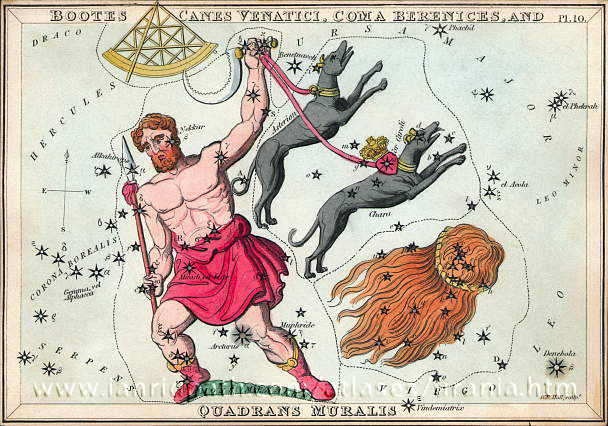
Since oldest times Arcturus has been one of the most prominent stars of
heaven used as a calendar star as described from Hesiod:
"(ll. 609-617) But when Orion and Sirius are come into mid-heaven, and
rosy-fingered Dawn sees Arcturus (30), then cut off all the grape-
clusters, Perses, and bring them home." (Hesiod)
As Arcturus was such a prominent star, a calendar star, situated in a
position below the “girdle” of Bootes, who is described as a watchman it
would be very tempting to identify this star with the sword we are
looking for, but in the whole Greek tradition Arcturus is (to our
knowledge) never described as a sword. However, looking into veddic
traditions and astronomy we find indeed the trace we are looking for:
“In India Arcturus was the 13th
nakshatra (Hindu
Moon Mansion),
Svati, the Good Goer, or perhaps Sword, but figured as a
Coral Bead, Gem, or Pearl; and known there also as
Nishtya, Outcast, possibly from its remote northern
situation far outside of the zodiac, whence, from its brilliancy, it was
arbitrarily taken to complete the series of Hindu asterisms (Richard H.
Allen
Star Names,
p.98.).
The Subterranean Smithy and the Treasure Chest
As we were able to identify Volund, his sword and his ring, Nidud and
Bodhild by using just verse 18 and 19 as a guide to the starry sky, we
should also be able to find Volund's smithy and explain astronomically
the episode where Volund kills the two sons of Nidud. It is described in
the following strophes:
The evil was open | when in they looked;
To the boys it seemed | that gems they saw,
Gold in plenty | and precious stones.
24. They came to the chest, | and they craved the keys,
The evil was open | when in they looked;
He smote off their heads, | and their feet he hid
Under the sooty | straps of the bellows.
36. "Seek the smithy | that thou didst set,
Thou shalt find the bellows | sprinkled with blood;
I smote off the heads | of both thy sons,
And their feet 'neath the sooty | straps I hid.
Just below the constellation Hercules we find the constellation of
Ophiuchus. This constellation is normally seen as a man holding a giant
serpent. On the other hand the
constellation serpent is depicted on the sky as divided into two
constellations, the head and the tail of the serpent.
It is now very interesting to look on the way the stars of Ophiuchus are
normally connected on star maps as in the figure below. Indeed this
constellation looks like a house or a chest. This has been noticed
before, Björn Jonnson interpreted it e.g. as the door of Valhall.
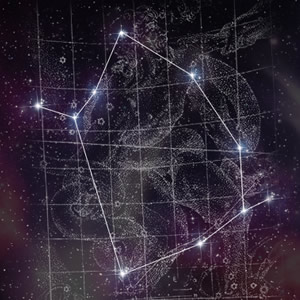
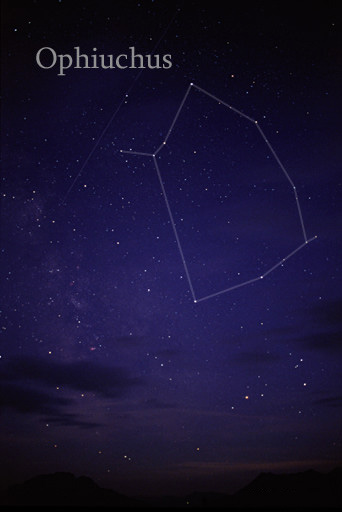
Ophiuchus, the constellation in the shape of a house or chest
If we take both observations together we can see in fact a chest and in
front of the chest a constellation called the head of the serpent, the
other part of the figure being the tail of the serpent. The two parts of
the constellation Serpent can be interpreted as parts of the slaughtered
sons. In the following strophes we find additional interesting
information about the fate of the dissected brothers.
25. Their
skulls, once hid |
by their hair, he took,
Set them in silver | and
sent them to Nithuth;
Gems full fair |
from their eyes he
fashioned,
To Nithuth's wife | so wise he gave them.
26. And from the
teeth | of
the twain he wrought
A brooch for the breast, |
to Bothvild he sent it;
. . . . . . . . . .
Völund spoke:
27. Bothvild then | of
her ring
did boast,
. . . . . . . . . .
. . . . . | "The
ring I have
broken,
I dare not say it | save to thee."
37. "Their skulls, once hid | by their hair, I took,
Set them in silver | and sent them to Nithuth;
Gems full fair | from their eyes I fashioned,
To Nithuth's wife | so wise I gave them.
38. "And from the teeth | of the twain I wrought
A brooch for the breast, | to Bothvild I gave it;
Now big with child | does Bothvild go,
The only daughter | ye two had ever."
Both the silver cup and the brooch can be found without a problem to represent star constellations. The cup is the constellation Crater placed near Hydra and the brooch made out of the teeth is seen as Corona Borealis. Indeed Corona Borealis looks like a jawbone with teeth. Only the eyes of the sons turned into gems are too non-specific to be identified in the sky.
Nidud's wife
The identification of Nidud's wife must remain unfortunately pure
speculation based on Völundarkviða alone,
as nothing in the poem helps to identify her. It should therefore
only be mentioned here that today’s constellation of Virgo is a merger
of two once independent constellations representing women, the second one
being part of Virgo and today's Coma Berenices.

Summary:
Taking together our findings it seems that we achieved our task to find
with the help of Greek and Roman traditions constellations that would
fit to the hints disclosed from the poet of Völundarkviða. We might
therefore be able to identify
Volund with his bended knee (Hercules), Bodhild (Virgo), Volund's ring
(Spica), Volunds sword (Arcturus) and Nidud (Bootes) as
constellations of the northern sky. The smithy of Volund can be compared
to
Ophiuchus, the
constellations of the head and the tail of the serpent (Serpens Caput
and Serpens Cauda) representing parts of the dead brothers. Other parts
can be seen in the shape of a (broken) brooch in
Corona Borealis and as a
silver cup in
Crater.
Altogether the Völundarkviða describes a cluster of constellations in a
certain region within the arch of the
Milky Way. This region is
identical with Nidud's realm with the Milky Way as its border.
